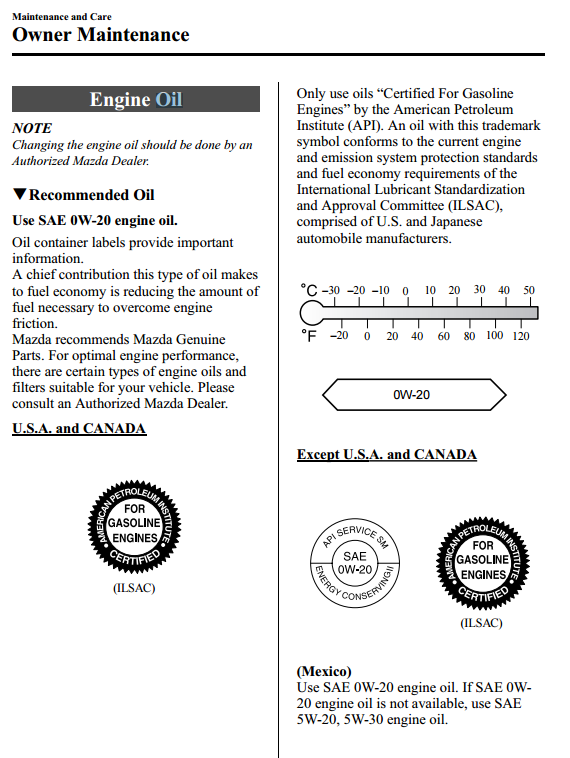 "Full of the sound of the Gran Fury, signifying nothing." (granfury)
"Full of the sound of the Gran Fury, signifying nothing." (granfury)
03/20/2016 at 14:51 ē Filed to: None
 0
0
 14
14
 "Full of the sound of the Gran Fury, signifying nothing." (granfury)
"Full of the sound of the Gran Fury, signifying nothing." (granfury)
03/20/2016 at 14:51 ē Filed to: None |  0 0
|  14 14 |

I drive a 2012 Mazda5 6MT as my DD. For routine service I used to take the car to the dealer where I bought it, but in the last year or two have been going to a different dealer that was closer to my office. With a coupon, the price is comparable to the quick change places that I donít trust; Iíd do it myself, but with only street parking itís a bit of a pain, especially in winter. On Friday I stopped in for an oil change at a different branch of the same dealer where I bought the car and they told me that Iíve been using the wrong oil for the last few years.
Per the oil filler cap, this 2.5l MZR engine requires 0W-20. The dealer Iíve been going to has been putting in 5W-20 conventional oil. The service writer last Friday insisted that I needed synthetic oil in order to meet the 0W-20 requirement.
Weíre not talking about a huge difference in viscosity here. Iím in St. Louis, and it really doesnít get that cold out here, not like Chicago or Detroit or climes further north. When itís cold out I gently start the engine, and let the car warm up a tad as I clean off the snow and ice. Partial throttle is used until the engine is up to full operating temp as shown on DashCommand (and not just by the cold engine idiot light going out).
I can understand why my MBZ needed premium fuel and Mobil1, but this Mazda is a basic transportation appliance, not a high-performance monster. If anything, Iím more concerned about the relatively low 20 weight during summer months - it gets hot out here. Back in SoCal I would run 20W-50 year round, and wonder if I should be running something like that out here during summer. The thinner oil, as indicated on the filler cap, is probably just for efficiency figures and not longevity, and makes me wonder if Iím doing more damage running 20 weight during the summer as compared to running 5 weight instead of 0 during winter.
What does the ownerís manual say, you ask? I donít know - I canít find a copy online, and my printed version is at home somewhere.
So, is the dealer trying to up-sell me on the synthetic oil on the change? Am I really doing that much damage to my engine running an ever-so-slightly thicker oil during winter? I baby this engine, so I canít believe that there is really any damage being done during this time.
 TheRealBicycleBuck
> Full of the sound of the Gran Fury, signifying nothing.
TheRealBicycleBuck
> Full of the sound of the Gran Fury, signifying nothing.
03/20/2016 at 15:08 |
|

http://filemanager.evolio.ca/450MAZDABLAINVÖ
 bryan40oop
> Full of the sound of the Gran Fury, signifying nothing.
bryan40oop
> Full of the sound of the Gran Fury, signifying nothing.
03/20/2016 at 15:08 |
|
You at least need a syn blend if youíre OCI is above 3k miles. As far as 0w20 - 5w20, not that much difference. Honda/toyota used to use 5w20, but released a TSB saying 0w20 is prefered as all their new models use it. I can only imagine itís for stretching MPG. The engines didnít change.
 Full of the sound of the Gran Fury, signifying nothing.
> TheRealBicycleBuck
Full of the sound of the Gran Fury, signifying nothing.
> TheRealBicycleBuck
03/20/2016 at 15:14 |
|
Thanks for the link. If 5W-20 is OK in Mexico, why isnít it OK in the USA?
 Full of the sound of the Gran Fury, signifying nothing.
> bryan40oop
Full of the sound of the Gran Fury, signifying nothing.
> bryan40oop
03/20/2016 at 15:18 |
|
270K so far on the original engine in the 525i using Castrol GTX 20W-50, but thatís an older car. It just seems wasteful to throw out even synthetic blend after 5K miles. Oil is better than ever - why are we disposing of it so soon?
 BrianGriffin thinks ďreliableĒ is just a state of mind
> Full of the sound of the Gran Fury, signifying nothing.
BrianGriffin thinks ďreliableĒ is just a state of mind
> Full of the sound of the Gran Fury, signifying nothing.
03/20/2016 at 15:26 |
|
Correct me if Iím wrong, but I donít believe outside temp really has anything to do with lubrication, as the operating temp of the engine (180-200) will always surpass the air. Winter, yes, weight does make a difference for cold starts.
 BloodlessWeevil
> Full of the sound of the Gran Fury, signifying nothing.
BloodlessWeevil
> Full of the sound of the Gran Fury, signifying nothing.
03/20/2016 at 15:30 |
|
Forget winter and summer, your oil viscosity changes far more going from ambient temp to operating temp. Even on the hottest day of summer, your oil relatively cold when you first start the engine. Most wear on engine components happens in the first few minutes after starting. That is the real benefit of multi-weight oils. Using oil that is more viscous at low temp will reduce the life of the engine even if it is the recommended viscosity at operating temperature.
In this case going easy on it does not make a difference, a revolution is a revolution whether it is at idle or the redline.
Side note: Manufacturers can now use 20 weight oil because manufacturing methods have improved the fit of cylinder rings in the cylinders. Reducing pumping and friction loses are a happy side effect.
 Full of the sound of the Gran Fury, signifying nothing.
> BrianGriffin thinks ďreliableĒ is just a state of mind
Full of the sound of the Gran Fury, signifying nothing.
> BrianGriffin thinks ďreliableĒ is just a state of mind
03/20/2016 at 15:43 |
|
Youíre probably right. When I trained as a tech, you went with the higher viscosity during hotter months, but Iím thinking that oils have gotten better and that the thicker oil really isnít all that necessary anymore. With the tighter tolerances in todayís engines, thicker oils would probably be even more of a problem.
 Berang
> Full of the sound of the Gran Fury, signifying nothing.
Berang
> Full of the sound of the Gran Fury, signifying nothing.
03/20/2016 at 15:48 |
|
0w-20 vs. 5w-20, the difference is only going to matter at start up when the oil and engine are cold. Once warmed up there shouldnít be any difference. Iím guessing the 0w-20 is intended to help cars that will be driven in cold climates to get the oil flowing through the engine faster. But once itís warm it wonít make a difference.
 Full of the sound of the Gran Fury, signifying nothing.
> Berang
Full of the sound of the Gran Fury, signifying nothing.
> Berang
03/20/2016 at 15:59 |
|
Thatís what I figured. Given how quickly engines warm up these days I have a hard time believing that running 5W-20 during the winter months, with an average low of 26 degrees F here in STL, is going to have a significant effect on the longevity of my engine. The specs are written for the worst case scenario, and Iím in an area that doesnít fit into that category.
Perhaps when Iím gainfully employed again Iíll do synthetic, but I suspect that good conventional 5W-20 oil, changed every 5K miles, can probably be considered safe and prudent and wonít shorten the life of my engine.
 gmporschenut also a fan of hondas
> Full of the sound of the Gran Fury, signifying nothing.
gmporschenut also a fan of hondas
> Full of the sound of the Gran Fury, signifying nothing.
03/20/2016 at 16:05 |
|
availability, cost, emissions. mpg.
0w grade became popular 10 years ago with automakers trying to ek out .2mpg gain.
If they set a mpg benchmark using it, use of 5-20 might not meet it and then have to deal with an angry customer demanding why arenít they getting the states mpg.
odd because there really isnít a difference in price between 5w-30 and 0w-30.
 bryan40oop
> Full of the sound of the Gran Fury, signifying nothing.
bryan40oop
> Full of the sound of the Gran Fury, signifying nothing.
03/20/2016 at 19:57 |
|
Cheap insurance.
 TheRealBicycleBuck
> Full of the sound of the Gran Fury, signifying nothing.
TheRealBicycleBuck
> Full of the sound of the Gran Fury, signifying nothing.
03/20/2016 at 22:44 |
|
That looks like an availability issue.
 CaptDale - is secretly British
> Full of the sound of the Gran Fury, signifying nothing.
CaptDale - is secretly British
> Full of the sound of the Gran Fury, signifying nothing.
03/21/2016 at 17:18 |
|
All new Suabru 4 cyl non turbos take 0w-20 syth no matter what.
 Tanner
> Full of the sound of the Gran Fury, signifying nothing.
Tanner
> Full of the sound of the Gran Fury, signifying nothing.
09/01/2017 at 15:16 |
|
All about the C.A.F.E standards and trying to stretch†mileage throughout the fleet.